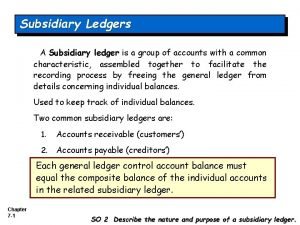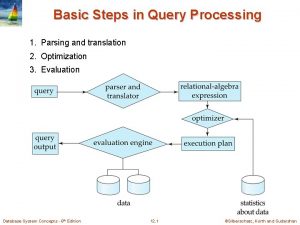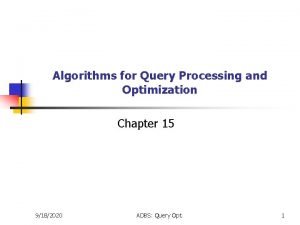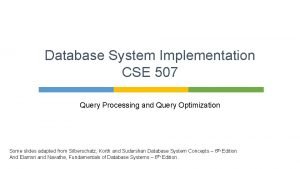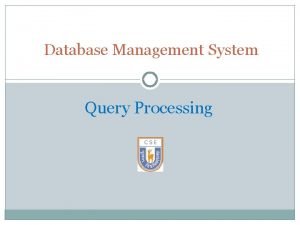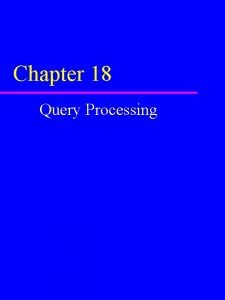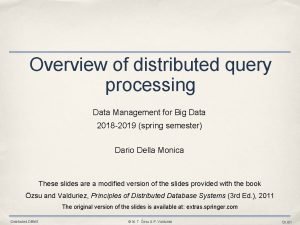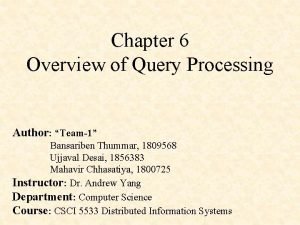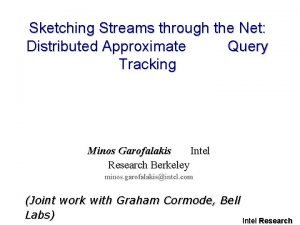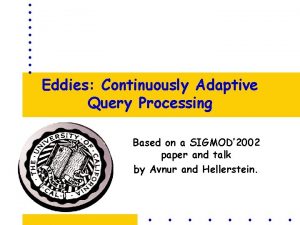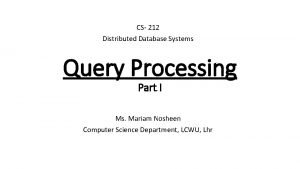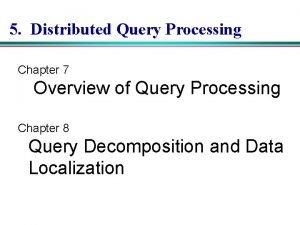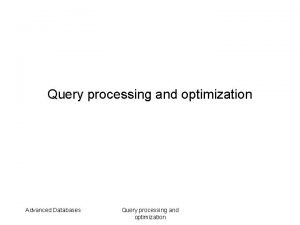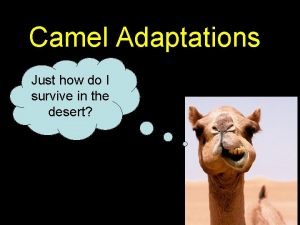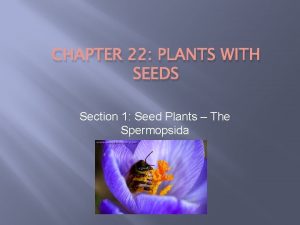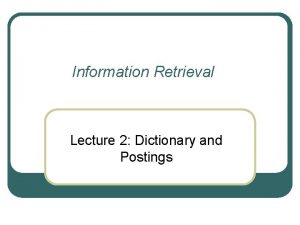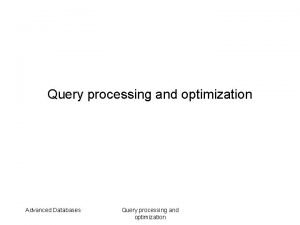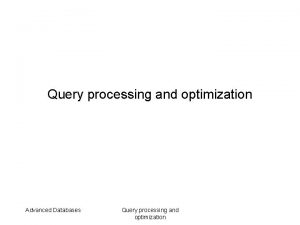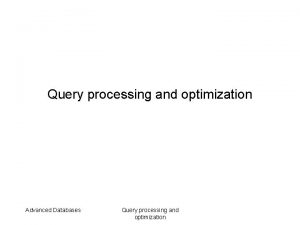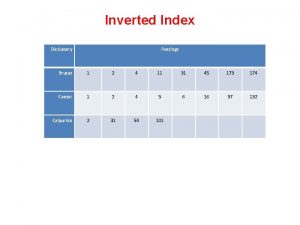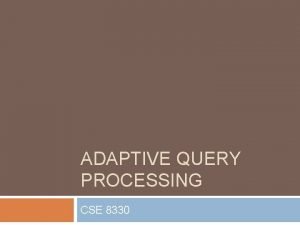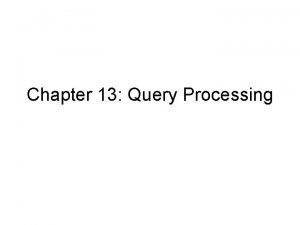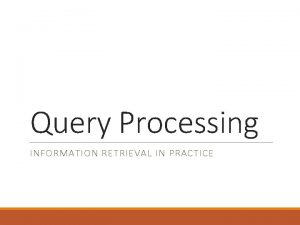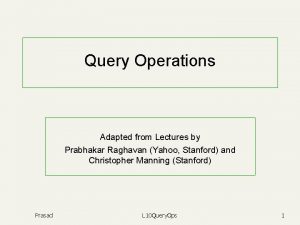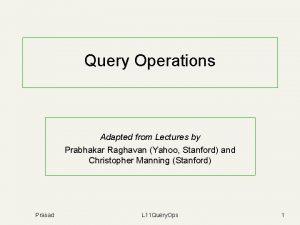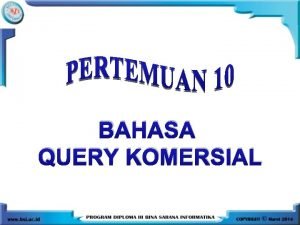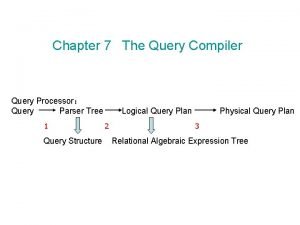Dictionary and Postings Query Processing Adapted from Lectures














































- Slides: 46

Dictionary and Postings; Query Processing Adapted from Lectures by Prabhakar Raghavan (Google) and Christopher Manning (Stanford) Prasad L 4 Dictonary. And. QP 1

This lecture agenda n n n Difficulties with tokenization Improving efficiency using enhanced data structures and algorithms : Skip pointers Phrasal queries n Generalizing indexing structures 2

Recall basic indexing pipeline Documents to be indexed. Friends, Romans, countrymen. Tokenizer Token stream. Friends Romans Linguistic modules Modified tokens. Inverted index. friend roman Countrymen countryman Indexer friend 2 4 roman 1 2 countryman 13 16

Parsing a document n What format is it in? n n n pdf/word/excel/html? What language is it in? What character set is in use? Each of these is a classification problem. But these tasks are often done heuristically … 4

Complications: Format/language n Documents being indexed can include docs from many different languages n n Sometimes a document or its components can contain multiple languages/formats n n A single index may have to contain terms of several languages. French email with a German pdf attachment. What is a unit document? n n A file? An email? (Perhaps one of many in an mbox. ) An email with 5 attachments? A group of files (PPT or La. Te. X in HTML) 5

Tokenization 6

Tokenization n n Input: “Friends, Romans and Countrymen” Output: Tokens n Friends n Romans n Countrymen Each such token is now a candidate for an index entry, after further processing But what are valid tokens to emit? 7

Tokenization n Issues in tokenization: n Finland’s capital Finland? Finlands? Finland’s? n Hewlett-Packard Hewlett and Packard as two tokens? n n State-of-the-art: break up hyphenated sequence. co-education ? It’s effective to get the user to put in possible hyphens San Francisco: one token or two? How do you decide it is one token? 8

Numbers n n n 3/12/91 Mar. 12, 1991 55 B. C. B-52 My PGP key is 324 a 3 df 234 cb 23 e 100. 2. 86. 144 n Often, don’t index as text. n n n But often very useful: think about things like looking up error codes/stacktraces on the web (One answer is using n-grams. ) Will often index “meta-data” separately n Creation date, format, etc. 9

Tokenization: Language issues n L'ensemble one token or two? n n n L ? L’ ? Le ? Want l’ensemble to match with un ensemble German noun compounds are not segmented n n Lebensversicherungsgesellschaftsangestellter ‘life insurance company employee’ 10

Tokenization: Language issues n Chinese and Japanese have no spaces between words: n n Cannot always guarantee a unique tokenization Further complicated in Japanese, with multiple alphabets intermingled n Dates/amounts in multiple formats フォーチュン 500社は情報不足のため時間あた$500 K(約6, 000万円) Katakana Hiragana Kanji Romaji End-user can express query entirely in hiragana! 11

Tokenization: Language issues n n n Arabic (or Hebrew) is basically written right to left, but with certain items like numbers written left to right Words are separated, but letter forms within a word form complex ligatures. ﻋﺎﻣﺎ ﻣﻦ ﺍﻻﺣﺘﻼﻝ ﺍﻟﻔﺮﻧﺴﻲ 132 ﺑﻌﺪ 1962 ﺍﺳﺘﻘﻠﺖ ﺍﻟﺠﺰﺍﺋﺮ ﻓﻲ ﺳﻨﺔ ← → ←→ ← start ‘Algeria achieved its independence in 1962 after 132 years of French occupation. ’ With Unicode, the surface presentation is complex, but the stored form is straightforward 12

Normalization n Need to “normalize” terms in indexed text as well as query terms into the same form n n We most commonly implicitly define equivalence classes of terms n n e. g. , by deleting periods in a term Alternative is to do asymmetric expansion: n n We want to match U. S. A. and USA Enter: window Search: window, windows Enter: windows Search: Windows, windows Enter: Windows Search: Windows Potentially more powerful, but less efficient 13

Normalization: Other languages n n Accents: résumé vs. resume. Most important criterion: n n n How are your users likely to write their queries for these words? Even in languages that have accents, users often may not type them German: Tuebingen vs. Tübingen n Should be equivalent 14

Normalization: Other languages n Need to “normalize” indexed text as well as query terms into the same form 7月30日 vs. 7/30 n Character-level alphabet detection and conversion n n Tokenization not separable from this. Sometimes ambiguous: Morgen will ich in MIT … Is this German “mit”? 15

Case folding n Reduce all letters to lower case n exception: upper case (in mid-sentence? ) n n e. g. , General Motors Fed vs. fed SAIL vs. sail Often best to lower case everything, since users will use lowercase regardless of ‘correct’ capitalization… 16

Stop words n With a stop list, you exclude from dictionary entirely, the commonest words. Intuition: n n n They have little semantic content: the, a, and, to, be They take a lot of space: ~30% of postings for top 30 But the trend is away from doing this indiscriminately: n n n Good compression techniques mean the space for including stopwords in a system is very small Good query optimization techniques mean you pay little at query time for including stop words. You need them for: n n n Phrase queries: “King of Denmark” Various song titles, etc. : “Let it be”, “To be or not to be” “Relational” queries: “flights to London” 17

Thesauri and soundex n Handle synonyms and homonyms n Hand-constructed equivalence classes n n n Index such equivalences n n e. g. , car = automobile color = colour When the document contains automobile, index it under car as well (usually, also viceversa) Or expand query? n When the query contains automobile, look under car as well 18

Soundex n Traditional class of heuristics to expand a query into phonetic equivalents n n n Language specific – mainly for names E. g. , chebyshev tchebycheff More on this later. . . 19

Lemmatization n n Reduce inflectional/variant forms to base form E. g. , n am, are, is be n car, cars, car's, cars' car the boy's cars are different colors the boy car be different color Lemmatization implies doing “proper” reduction to dictionary headword form 20

Stemming n n Reduce terms to their “roots” before indexing “Stemming” suggest crude affix chopping n n language dependent e. g. , automate(s), automatic, automation all reduced to automat. for example compressed and compression are both accepted as equivalent to compress. for exampl compress and compress ar both accept as equival to compress 21

Porter’s algorithm n Commonest algorithm for stemming English n n Results suggest at least as good as other stemming options Conventions + 5 phases of reductions n n n phases applied sequentially each phase consists of a set of commands sample convention: Of the rules in a compound command, select the one that applies to the longest suffix. 22

Typical rules in Porter n n n sses ss ies i ational ate tional tion Weight of word sensitive rules (m>1) EMENT → n n replacement → replac cement → cement 23

Other stemmers n Other stemmers exist, e. g. , Lovins stemmer http: //www. comp. lancs. ac. uk/computing/research/stemming/general/l ovins. htm n n Single-pass, longest suffix removal (about 250 rules) Motivated by linguistics as well as IR Full morphological analysis – at most modest benefits for retrieval Do stemming and other normalizations help? n Often very mixed results: really help recall for some queries but harm precision on others 24

Language-specificity n Many of the above features embody transformations that are n n Language-specific and Often, application-specific These are “plug-in” addenda to the indexing process Both open source and commercial plug-ins available for handling these 25

Dictionary entries – first cut ensemble. french 時間. japanese MIT. english mit. german guaranteed. english entries. english sometimes. english tokenization. english These may be grouped by language (or not…). More on this in ranking/query processing. 26

Faster postings merges: Skip pointers 27

Recall basic merge n 2 Walk through the two postings simultaneously, in time linear in the total number of postings entries 8 2 4 8 41 1 2 3 8 48 64 11 17 21 Brutus 31 Caesar 128 If the list lengths are m and n, the merge takes O(m+n) operations. Can we do better? Yes, if index isn’t changing too fast. 28

Augment postings with skip pointers (at indexing time) 41 2 11 1 n 2 8 3 41 8 48 31 64 11 17 128 21 31 Why? n n 4 128 To skip postings that will not figure in the search results. How? n Where do we place skip pointers? 29

Query processing with skip pointers 41 2 11 1 4 2 8 3 128 41 8 48 31 11 64 17 Sec. 2. 3 128 21 31 Suppose we’ve stepped through the lists until we process 8 on each list. We match it and advance. We then have 41 and 11 on the lower. 11 is smaller. But the skip successor of 11 on the lower list is 31, so we can skip ahead past the intervening postings. 30

Section 2. 3 : Page 35 (print) / Page 37 (online) 31

Where do we place skips? n Space-time Tradeoff: n n More skips shorter skip spans more likely to skip. But lots of comparisons to skip pointers. Fewer skips few pointer comparison, but then long skip spans few successful skips. 32

Placing skips n n Simple heuristic: for postings of length L, use L evenly-spaced skip pointers. This ignores the distribution of query terms. Easy if the index is relatively static; harder if L keeps changing because of updates. This definitely used to help; with modern hardware it may not (Bahle et al. 2002) n The cost of loading a bigger postings list outweighs the gain from quicker in-memory merging 33

Phrase queries 34

Phrase queries n n Want to answer queries such as “stanford university” – as a phrase Thus the sentence “I went to university at Stanford” is not a match. n n The concept of phrase queries easily understood by users; about 10% of web queries are phrase queries No longer suffices to store only <term : docs> entries 35

Solution 1: Biword indexes n n Index every consecutive pair of terms in the text as a phrase For example the text “Friends, Romans, Countrymen” would generate the biwords n friends romans n romans countrymen Each of these biwords is now a dictionary term Two-word phrase query-processing is now immediate. 36

Longer phrase queries n stanford university palo alto can be broken into the Boolean query on biwords: stanford university AND university palo AND palo alto Without the docs, we cannot verify that the docs matching the above Boolean query do contain the phrase. Can have false positives!

Extended biwords n n n Parse the indexed text and perform part-of-speechtagging (POST). Bucket the terms into (say) Nouns (N) and articles/prepositions (X). Now deem any string of terms of the form NX*N to be an extended biword. n n Each such extended biword is now made a term in the dictionary. Example: catcher in the rye N n X X N Query processing: parse it into N’s and X’s n n Segment query into enhanced biwords Look up index 38

Issues for biword indexes n n False positives, as noted before Index blowup due to bigger dictionary For extended biword index, parsing longer queries into conjunctions: n E. g. , the query tangerine trees and marmalade skies is parsed into n tangerine trees AND trees and marmalade AND marmalade skies Not standard solution (for all biwords) 39

Solution 2: Positional indexes n Store, for each term, entries of the form: <number of docs containing term; doc 1: position 1, position 2 … ; doc 2: position 1, position 2 … ; etc. > 40

Positional index example <be: 993427; 1: 7, 18, 33, 72, 86, 231; 2: 3, 149; 4: 17, 191, 291, 430, 434; 5: 363, 367, …> n n Which of docs 1, 2, 4, 5 could contain “to be or not to be”? Can compress position values/offsets Nevertheless, this expands postings storage substantially 41

Processing a phrase query n n Extract inverted index entries for each distinct term: to, be, or, not. Merge their doc: position lists to enumerate all positions with “to be or not to be”. n to: n n be: n n 2: 1, 17, 74, 222, 551; 4: 8, 16, 190, 429, 433; 7: 13, 23, 191; . . . 1: 17, 19; 4: 17, 191, 291, 430, 434; 5: 14, 19, 101; . . . Same general method for proximity searches

Proximity queries n n LIMIT! /3 STATUTE /3 FEDERAL /2 TORT Here, /k means “within k words of”. Clearly, positional indexes can be used for such queries; biword indexes cannot. 43

Positional index size n n Can compress position values/offsets Nevertheless, a positional index expands postings storage substantially Nevertheless, it is now used because of the power and usefulness of phrase and proximity queries … whether used explicitly or implicitly in a ranking retrieval system. 44

Positional index size n n Need an entry for each occurrence, not just once per document Index size depends on average document Why? size n n n Average web page has <1000 terms SEC filings, books, even some epic poems … easily 100, 000 terms Consider a term with frequency 0. 1% Document size Postings Positional postings 1000 1 1 100, 000 1 100

Rules of thumb A positional index is 2– 4 times as large as a nonpositional index n Positional index size 35– 50% of volume of original text n Caveat: all of this holds for “English-like” languages Combinational Schemes: n Positional and biword approaches can be profitably combined n For particular phrases (“Michael Jackson”, “Britney Spears”) it is inefficient to keep on merging positional n postings lists n Even more so for phrases like “The Who” 46
 Query tree and query graph
Query tree and query graph Query tree and query graph
Query tree and query graph Iterative vs recursive dns
Iterative vs recursive dns Postings are made daily to subsidiary ledgers so that:
Postings are made daily to subsidiary ledgers so that: Algonquin gas transmission informational postings
Algonquin gas transmission informational postings Siue ga posting
Siue ga posting Steps of query processing
Steps of query processing Algorithms for query processing and optimization
Algorithms for query processing and optimization Steps in query processing
Steps in query processing Query optimization steps
Query optimization steps Steps of query processing
Steps of query processing Measures of query cost in dbms
Measures of query cost in dbms Objectives of query processing
Objectives of query processing Steps in query processing
Steps in query processing Distributed query processing in dbms
Distributed query processing in dbms Characteristics of query processor
Characteristics of query processor Sketch techniques for approximate query processing
Sketch techniques for approximate query processing What is the role of eddy in adaptive query processing
What is the role of eddy in adaptive query processing Distributed query processing
Distributed query processing Distributed query processing
Distributed query processing Distributed query processing
Distributed query processing Basic steps in query processing
Basic steps in query processing Sql server intelligent query processing
Sql server intelligent query processing Utilities and energy lectures
Utilities and energy lectures What is text linguistics
What is text linguistics Molecular biology lectures
Molecular biology lectures This passage is adapted from jane austen
This passage is adapted from jane austen Erythroposis
Erythroposis Adapted with permission from
Adapted with permission from In what ways have the highland maya adapted to modern life?
In what ways have the highland maya adapted to modern life? Xerophyte adaptations
Xerophyte adaptations Climate of the chaparral biome
Climate of the chaparral biome Adaptation of camel in points
Adaptation of camel in points Sausage shaped organelles
Sausage shaped organelles Best brother quotes
Best brother quotes Adapted from the internet
Adapted from the internet How is amoeba adapted for gas exchange bbc bitesize
How is amoeba adapted for gas exchange bbc bitesize How have plants adapted to the rainforest
How have plants adapted to the rainforest Spermopsida plants
Spermopsida plants The outsiders adapted for struggling readers
The outsiders adapted for struggling readers Identify synoynm
Identify synoynm Behavioral adaptations of zebras
Behavioral adaptations of zebras Neighborhood processing
Neighborhood processing Primary processed food
Primary processed food Batch processing and interactive processing
Batch processing and interactive processing Rick trebino
Rick trebino Neonatology lectures
Neonatology lectures



